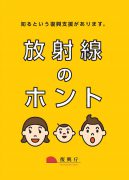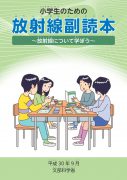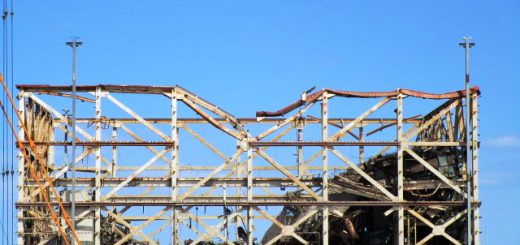Government publications play down radiation risks
By Kataoka Ryohei (CNIC)
The Reconstruction Agency’s ‘Truth about Radiation’

The Reconstruction Agency compiled a 30-page, A5-sized booklet titled Hoshasen no Honto (Truth about Radiation), which it published and began distributing in March 2018. As of November 2018, 22,000 copies had been distributed to relevant government agencies and participants of functions such as PTA conventions (in Saga and Niigata) in and outside of Fukushima Prefecture. It is part of a “safety campaign” aimed at promoting recovery from the Fukushima nuclear accident.
It presents a one-sided view, saying for example, “No proof of health impacts has been found (from the Fukushima Daiichi nuclear accident),” “The occurrences of numerous cases of thyroid cancer from radiation are considered not worthy of consideration,” “The amount of radiation in the major cities of Fukushima is decreasing,” and “The people who have gone back to their hometowns are returning to their normal livelihoods.”
It contains three particularly big mistakes that were pointed out in citizen group negotiations with the government held in December 2018. One is the statement that the effects of radiation are “not inherited genetically.” The Ministry of the Environment’s “Integrated basic information on health effects caused by radiation” (published in 2015) states that “The International Commission on Radiological Protection (ICRP) estimates the risk of hereditary influence at 0.2% per Gray.” It is a mistake to conclude that the effects are not passed along genetically.
The second mistake is found in the “Standards for radioactive materials in foods” table (shown below) regarding cesium 134 and 137. The figures on Japan’s standards for food in “normal” times are identical to the figures of the EU, US and Codex Alimentarius Commission for times of emergency. The booklet compares figures from circumstances so different as to be incomparable and states “standards are set at the world’s strictest level.” The truth is that the standards for drinking water at normal times are 8.7 Bq/kg in the EU, 4.2 Bq/kg in the US and not specified under the Codex Alimentarius. The Ministry of Health, Labor and Welfare (MHLW), the Consumer Affairs Agency and the Reconstruction Agency have all recognized this error, but it remains uncorrected at present.

The third mistake is the statement that “The increase in cancer risk due to 100-200 milliSieverts (mSv) exposure is about the same as from insufficient vegetable consumption or excessive salt intake.” The National Cancer Center of Japan, which provided the original data on cancer risk from lifestyle choices such as eating too few vegetables, announced in 2008 that it could not find any connection between vegetables and cancer. Making such a comparison in spite of that can only be called intentionally dishonest in that the booklet attempts to make exposure look less risky than it is.
For whom was this booklet written? The Reconstruction Agency says, “This is a booklet for the general public aimed at dispelling misunderstandings that lead to groundless prejudices and discrimination,” and that it is meant for people in areas outside of Fukushima. The Reconstruction Agency has handled this extremely irresponsibly, saying “We don’t deny the necessity for radiological protection, but dealing with radiological protection is not our responsibility, the MHLW handles that.”
Despite having these mistakes pointed out to them, the Reconstruction Agency refuses to withdraw the booklet, saying “Safety is sufficiently assured” and “We have no intention of writing anything dishonest or unscientific.”
Based on recognition that preconceptions and misconceptions are arising not from the radiation from which people are suffering, but from insufficient knowledge, and that this lack of scientific knowledge is the cause of damage from harmful rumors, Hoshasen no Honto aims to eliminate “harmful rumors,” but it does that by trying to provide mistaken “knowledge.” Another big problem with the booklet is that it never touches on the government’s and TEPCO’s responsibility for the nuclear accident or the miserable living environment the accident’s victims have had to endure. The booklet ought to be retitled Lies about Radiation and promptly withdrawn.
MEXT’s Hoshasen Fukutokuhon

The Ministry of Education, Culture, Sports, Science and Technology (MEXT) published a 22-page, A4-sized revised edition of Hoshasen Fukutokuhon (Supplementary Reader on Radiation) in October 2018. The first edition in 2011 was compiled with a budget of about 200 million yen (about $1.65 million) from MEXT’s Research and Development Bureau and distributed to elementary, junior high and high schools, and community centers throughout Japan. The 2014 edition started with a page on the Fukushima nuclear accident and the damage it caused, but the revised edition starts out as the original one did from the statement that “Radiation exists all around us every day.”

Chapter 1 “Radiation, Radioactive Substances and Radioactivity,” states that the health impacts of radiation, that are used, for example, in medical treatments, are related to the amount of radiation rather than its presence or absence, and includes a table saying “relative risk hard to detect” for exposures of less than 100 mSv. It draws the erroneous interpretation that low exposure doses have no health impact. However, surveys in Hiroshima and Nagasaki support the view that there is no “lower limit” below which exposure to radiation has no effect. Therefore, the approach to radiation should start from clarifying that exposure to radiation always entails a risk of cancer.
Chapter 2 “The Nuclear Power Station Accident and the Road to Recovery” says only that the air dose in Fukushima Prefecture has decreased in the seven years since the accident, completely overlooking the fact that radiation levels are still higher in the contaminated regions, including neighboring prefectures, than they were before the accident and that forested areas exist that have not been decontaminated as do hot spots with high levels of radiation. It also fails to mention that the residents who have returned and are living there will face exposure over a long period into the future. It introduces only forward-looking initiatives toward reconstruction and revitalization of the region, overlooking the reality that even after the evacuation orders have been lifted, almost no children or young people have returned and the region has a high percentage of elderly residents.
Even if it stresses that radiation levels are safe and claims that the reason children from Fukushima are being bullied at schools is because of “rumors arising from ungrounded beliefs,” it cannot dispel those rumors this way.
Strategy to strengthen rumor elimination and risk communication
Hoshasen no Honto and Hoshasen Fukutokuhon are part of the Reconstruction Agency’s “Strategy to strengthen rumor elimination and risk communication.”This is a strategy of trying to force complete closure of the Fukushima nuclear accident in time for the Tokyo Olympics in 2020. It involves intensified transmission of information to let people “know” there is no harm being caused by the accident anymore, get them to “eat” produce from Fukushima and encourage them to “visit” Fukushima on school excursions and sightseeing tours.
The targets for this “information” are (1) young students and people such as teachers involved in their education, (2) expectant mothers and parents/guardians of infants and young students and (3) citizens in general. The revised edition of Hosha Fukutokuhon is central to the specific measures for this strategy. “Radiation safety education” is also being conducted as part of school staff training.
Refusing to face radiation risks squarely and pushing “risk communication” that denies health impacts is nothing but spreading propaganda. It will fail to resolve the issues, and will probably not lead to the recovery of Fukushima either. Both publications strongly deserve to be withdrawn.

